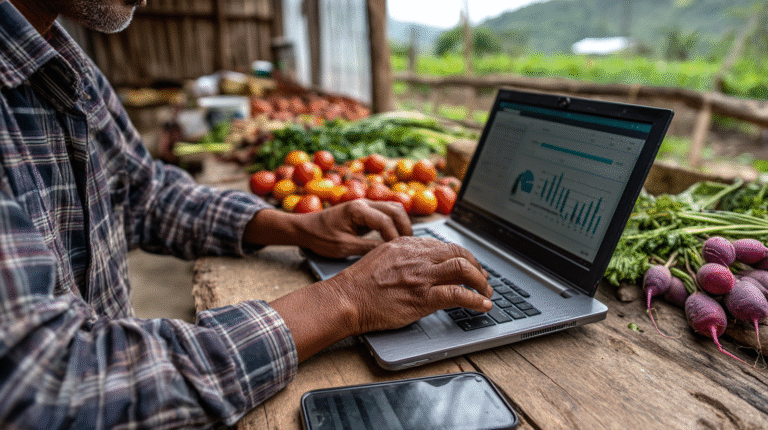Affordable Digital Marketing Strategies for Small-Scale Farmers
Small-scale farmers can enhance their digital presence without breaking the bank.
Focus on free platforms like Instagram and Facebook to showcase farm stories, using local hashtags during peak hours.
Build an email list at markets by offering sign-up incentives. Improve your Google Business Profile for free local visibility, and partner with nearby businesses for cross-promotion.
Don’t forget to track simple metrics like website visits and sales to see what’s working.
The strategies below will transform your farm’s online footprint.
Key Takeaways
- Optimize your Google Business Profile for free local visibility and submit a sitemap to Google Search Console to improve searchability.
- Create authentic behind-the-scenes content showing daily farm operations to build emotional connections with potential customers.
- Build email lists through market sign-ups or discount offers to directly reach customers without social media algorithm limitations.
- Use affordable tools like Canva for graphics and free scheduling platforms to maintain consistent posting across platforms.
- Form strategic partnerships with local restaurants and food influencers to expand reach without increasing marketing budget.
Want to Learn How to Rank #1 in Your Town?
Get the free checklist: “The 5 Quick Fixes to Get Found on Google Maps.”
Leveraging Free Social Media to Connect With Local Customers
While many small farmers hesitate to plunge into social media marketing, your farm’s success increasingly relies on a strong digital presence. Don’t worry – you’ve got this!
Choosing the right platforms is key for local visibility farms. Where are your customers hanging out? Instagram and Facebook are usually safe bets for agricultural businesses. Creating a unified brand image across these platforms will significantly strengthen customer recognition and trust.
Focus on platforms where your local customers already gather—Instagram and Facebook typically deliver for farm businesses.
Consider these quick wins:
- Post during peak hours when your audience is online
- Employ location-specific hashtags to reach nearby customers
- Share high-quality photos of your beautiful produce
- Host live Q&A sessions about your farming practices
Got 15 minutes? Update your profiles with consistent branding and current operation hours.
Remember to track what’s working! Monitor which posts drive actual farm visits or sales.
Encourage customers to share their experience with your products to develop valuable user-generated content that builds community trust.
Your social presence can transform curious scrollers into loyal customers.
Creating Authentic Farm Stories That Resonate Online
Your farm has a story worth sharing, but flashy marketing won’t cut it—you need authentic moments that connect with real people.
Show customers what happens behind the scenes with raw, unfiltered glimpses of your daily work (muddy boots and all). The power of your unique agricultural narrative provides consumers the awareness they lack about food production realities due to industrial convenience-focused messaging.
When you humanize your operation by highlighting the faces, challenges, and triumphs of farm life, you’ll create content that stops the scroll and builds lasting customer relationships. Consider how your choice of visual elements like fonts, colors, and logo design can significantly influence how your audience perceives your farm’s identity and values.
Show, Don’t Tell
The most powerful marketing doesn’t feel like marketing at all. When you share authentic glimpses of your farm life, you’re creating connections that outperform any sales pitch.
Those farm SEO wins happen when real stories meet strategic sharing. Your followers crave authenticity—they want to see:
- Morning harvest routines
- The struggle of weather challenges
- Your face beaming with pride beside fresh produce
Don’t just tell people your tomatoes are delicious. Show a chef’s reaction when tasting them for the first time!
Instagram Stories offer the perfect 24-hour window for quick peeks behind the curtain. Utilize polls and questions to turn passive scrollers into engaged participants. This approach is particularly effective since one-third of the most viewed Stories come from businesses.
While digital strategies are essential, incorporating storytelling and visuals from traditional marketing approaches can significantly enhance your online communication effectiveness.
Humanize Your Farm
Behind every small farm lies a story worth telling — one that transforms rows of vegetables into a narrative customers connect with emotionally. Your farm’s unique journey matters more than you might think.
When customers know your “why,” they become loyal supporters, not just one-time buyers.
| Story Element | SEO Impact | Social Reach |
| Family History | High search intent | Moderate engagement |
| Sustainable Practices | Featured snippets | Shareable content |
| Customer Testimonials | Review signals | Community building |
Don’t just post product photos. Share the muddy boots, early mornings, and triumph of your first successful harvest. While social media builds community, keep in mind that SEO drives ready-to-buy customers searching specifically for what you offer. Instagram Stories provide a perfect platform for behind-the-scenes glimpses that feel more spontaneous and authentic to followers. Studies show that emotional connection largely influences purchasing decisions, making your authentic farm story invaluable.
Your authentic story is your most powerful marketing tool!
Email Marketing: Building a Low-Cost Customer Database
Farmers struggling with social media algorithms and paid advertising have a secret weapon hiding in plain sight: email marketing.
Unlike social platforms where your content might reach only 5% of followers, emails land directly in your customers’ inboxes.
Building your list is simpler than you think:
- Place sign-up forms at farmers’ markets and on your website
- Offer a small discount for joining (everyone loves free stuff!)
- Collect emails in person during farm tours or events
Once you’ve gathered emails (legally, with permission!), segment your list by:
- Location
- Purchase history
- Interests (veggie lovers vs. fruit fanatics)
Personalized emails create stronger relationships with your subscribers and can significantly increase engagement levels when you include their names.
Automation saves precious time. Set up:
- Welcome emails for new subscribers
- Seasonal product announcements
- CSA reminders
Best part? Many platforms offer free plans for small lists. Consistent weekly contact with your buyers helps prevent your emails from being categorized as junk and maintains your farm’s presence in customers’ minds.
Optimizing Your Farm Website on a Budget
While Instagram posts showcase your gorgeous produce, your website works silently 24/7 converting curious browsers into loyal customers.
That’s why prioritizing local SEO over social media often delivers better ROI.
Start with these budget-friendly tweaks:
- Research keywords like “organic eggs near me” using free tools
- Create FAQ blog posts answering common customer questions
- Verify your site loads quickly (compress those tomato pics!)
- Install a free SSL certificate for security
- Submit your sitemap to Google Search Console
Don’t forget your Google Business Profile! It’s essentially free advertising when someone searches “farm fresh produce” in your area.
Need a quick win? Check for broken links using Screaming Frog’s free version.
Creating a dedicated page that serves as a comprehensive buying guide can significantly improve your conversion rates by clearly outlining all purchase options for potential customers.
Implementing responsive design ensures your farm website displays properly across all devices, which is crucial for reaching mobile customers browsing on their phones or tablets.
Your website is about to work harder than your trusty tractor!
Community-Based Digital Marketing Through Local Partnerships
Beyond your website’s digital footprint, the most powerful marketing doesn’t always come from your own channels.
Local partnerships amplify your reach while providing incredible SEO benefits farms often overlook. When restaurants tag your farm in their Instagram posts, you’re building backlinks that enhance your Google visibility!
Try these partnership approaches:
- Connect with chefs for farm-to-menu promotions that showcase your seasonal harvests.
- Arrange Instagram takeovers where local food influencers highlight your produce.
- Join forces with food co-ops for shared digital storefronts that pool resources.
- Create virtual farm tours for schools (parents are customers too!).
The best part? These collaborations often cost nothing but time. These digital marketplace connections help farmers retain more food dollars within their local communities. Implementing visual storytelling techniques can dramatically showcase your farm’s unique operations and seasonal offerings.
Remember: A single geotagged post from a respected restaurant carries more weight than dozens of solo posts.
Measuring What Works: Simple Analytics for Farm Businesses
You can’t improve what you don’t measure in your farm marketing efforts.
Tracking simple metrics like website visitors, email open rates, and which products sell after specific promotions gives you clear insight into what’s working.
These numbers aren’t just boring stats—they’re your roadmap to making smarter decisions about where to focus your limited time and marketing dollars.
Track Performance Metrics
Three essential tracking systems separate thriving farm businesses from struggling ones. Your organic traffic farms need consistent measurement to verify real growth—not just feel-good metrics.
First, monitor your core financials like net income per acre and cost efficiency. These numbers don’t lie!
Second, track farm efficiency indicators including:
- Yield per acre
- Labor hours per output
- Equipment utilization rates
Finally, don’t ignore market performance metrics. Are your sales actually growing? How’s your customer satisfaction trending?
The most successful farmers I know check these numbers weekly. They’re not obsessing—they’re staying informed.
Remember: “What gets measured gets managed.”
Pro tip: Create a simple dashboard with your top 5 metrics. Complexity is the enemy of consistent tracking.
Data-Driven Growth Decisions
Data-driven decisions separate hobby farms from profitable agricultural businesses. You don’t need fancy tech to make smarter choices!
Your farm generates valuable data every day:
- Track soil quality with affordable sensors
- Monitor crop health through smartphone apps
- Utilize free weather services to reduce risks
- Follow market pricing to time your sales perfectly
Start small—a simple spreadsheet tracking yields, costs, and sales can reveal surprising patterns.
The benefits are immediate:
- Targeted resource management (less waste on water and fertilizer)
- Better yield predictions
- Early identification of operational inefficiencies
- Improved risk management
Seasonal Content Planning for Year-Round Engagement
While the growing season might’ve its limits, your digital marketing doesn’t have to hibernate during the off-months. Effective seasonal content planning keeps your farm relevant in customers’ minds all year long.
Organize your approach with these quick tips:
- Align content with farming cycles – educational webinars in winter, planting highlights in spring
- Create monthly themes and break them into weekly content plans
- Utilize free tools like Canva for graphics and Hootsuite for scheduling
Mix it up with behind-the-scenes stories showing real farm challenges. Your authenticity builds connection!
Try partnering with other small-scale farmers to share marketing costs. Pooled resources = bigger impact.
Remember: Even when fields are dormant, your digital presence should stay active and engaging.
Related Questions
How Do I Manage Digital Marketing With Limited Internet Connectivity?
You can manage digital marketing with limited connectivity by utilizing offline content, scheduling internet sessions, using SMS marketing, employing lite app versions, and leveraging community networks. Solar-powered devices will help maintain basic connectivity.
Can Digital Marketing Work for Farmers Without Technical Skills?
Yes, digital marketing can work for you without technical skills. Start with user-friendly platforms like Facebook or Instagram, employ visual content, and make use of free tools. Consider partnerships with tech-savvy community members for additional support.
How Much Time Should Small-Scale Farmers Dedicate to Digital Marketing?
You should dedicate at least two hours weekly, focusing on SEO optimization and 2-3 social posts. Batch content during slow periods, utilize scheduling tools, and prioritize Google Business Profile over constant social media engagement.
Which Marketing Tactics Work Best for Specialty or Niche Farm Products?
For specialty farm products, you’ll find the best results by showcasing your unique value through content marketing, targeted SEO, and building direct relationships via email newsletters and partnerships with local restaurants or food influencers.
How Can I Balance Online Marketing With Traditional Farmer-Customer Relationships?
Balance digital and traditional connections by utilizing social media to improve, not replace, in-person relationships. Share your farm story online, promote market appearances, and employ email newsletters to support meaningful face-to-face customer interactions.
What it all boils down to
You’ve got this, farmer! With these affordable digital marketing strategies, you’re ready to connect with customers who are actively searching for what you grow.
Remember, it’s not about doing everything—it’s about doing the right things consistently. Start small, measure what works, and adjust as you go.
Your farm deserves to be found by the people who value it most.





